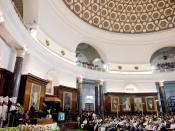INTRODUCTION
India has adopted the parliamentary form of democracy, also called the Westminster Model. The Government of India Act,1935 established a federation and copied the English Parliamentary form of Government. Our Constitution makers thought it prudent to follow the path down by the Act of 1935. In the Parliamentary system the Parliament performs a variety of functions.[1: See Article 79. Speaking in the Lok Sabha on March 28,1957, Shri Nehru acknowledged that India's Parliamentary institutions were modeled on those of Britain]
1. Cabinet is part of Parliament : It is the Parliament which provides the Cabinet. No person can continue to be a Minister for more than six months unless he is a member of either House of the Parliament.*
2. Control over the Cabinet : It is one of the more important functions and duties of Lok Sabha to ensure that the inistry remains in power only as long as it has the support of the majority in that House.1
3.Daily Answerability : The Ministers have to answer questions.reply to calling attention motions, move legislation and justify Government's actions while the working of different Departments of governmentare being discussed.
4. Financial Control : In regard to the Money Bill, Lok Sabha has a predominating role to perform. The expenditure to be incurred by the Government and the revenue to be collected by way of taxes must be approved by Lok Sabha.
5. Law making functions: In the Parliamentary form of Government all legislations are initiated by the Cabinet. By issuing a whip it is ensured that the Bill will have the support of the mojority of members. Parliament lays down the policies and bare framework in the Act and leaves it to the executive to frame rules,regulations etc. to carry out the provisions of the...


